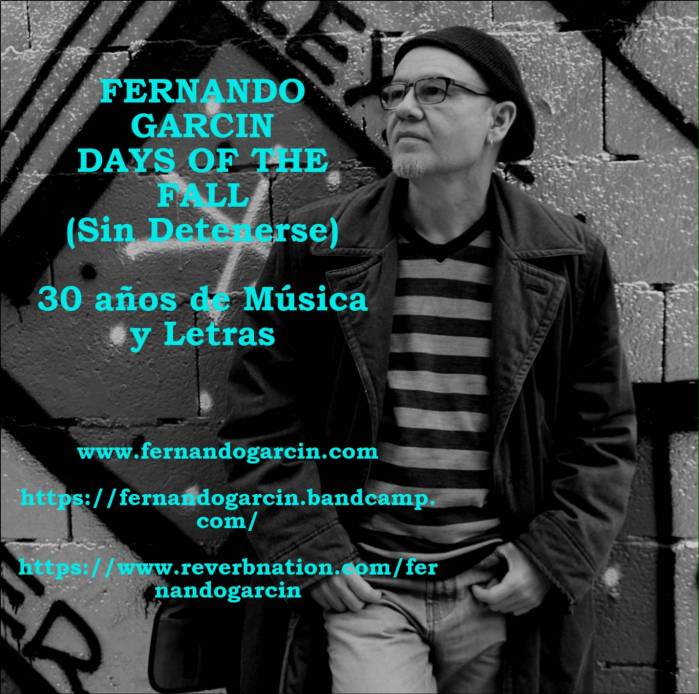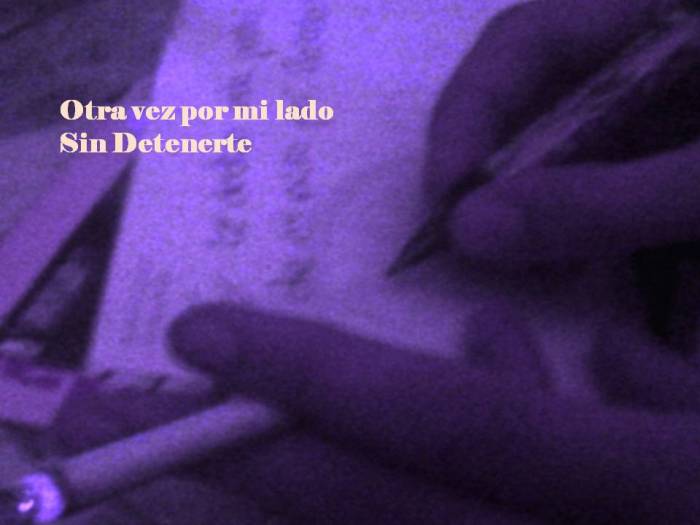NUNCA TUVE UN PLAN. 1.
(una serie de recuerdos)
I NEVER HAD A PLAN. 1.
(sketches from memory)
«Todo está escrito según la impresión del momento; no se ha pensado en un plan artístico general; es como cuando se derrama un jarro de agua.» (Goethe, Eckermann, 1823)
«On ne reçoit pas la sagesse, il faut la découvrir soi-même après un trajet que personne ne peut faire pour nous, ne peut nous épargner.»/ «We are not provided with wisdom, we must discover it for ourselves, after a journey through the wilderness which no one else can take for us, an effort which no one can spare us.”
(Marcel Proust)

Era invierno. Alrededor de 1971. Observo la foto. Una reunión familiar en casa de mis tíos, cerca de lo que hoy se llama “El Cedro”. El mayor era yo con unos 10 años y un micro. Mi primo Carles a la batería. Mi hermana Sole y mi prima Eva con guitarras. Las más peques bailando. Sobre esos mismos años, un verano en Siete Aguas, allí donde mis abuelos tenían la casa “Alquería dels Romeu”, organizamos una obra de teatro o performance basada en el Gran Dictador. Voy disfrazado de militar confederado con bigote hitleriano, mientras mi primo Carles va vestido de nativo americano. Sabíamos que el del bigote no iba a ganar. Niños jugando. De eso va todo. Entonces y ahora. Niños chapoteando. Niños jugando.

Mi padre fallece cuando tengo 15 años. Entre 1974 y 1978 los cambios son como mutaciones. El instituto era uno de mis paraísos. En ese periodo la curiosidad ávida me hizo ser lo que soy. El eclecticismo, la falta de rigidez, la mente abierta, nada de etiquetas ni definiciones, la esponja que lo absorbe todo sin prejuicios. Antes de 1980, leía a Marcel Proust, Thomas De Quincey, Antonio Machado, Miquel Martí i Pol, Estellés, Dylan Thomas, Jean Cocteau, Julio Cortázar, Jack Kerouac, Nietzsche, Oscar Wilde, Montserrat Roig, Carson McCullers… Escuchaba rock, clásica, jazz, blues, música folclórica, punk, new wave… Jacques Brel, La Rondalla de La Costa, jotas aragonesas, Patti Smith, Beethoven, Ian Dury, Kurt Weil, Lou Reed, Pau Riba, The Clash, música tradicional africana, Reggae, Ska, Sisa, Kevin Ayers, Bob Dylan, Leonard Cohen, Jordi Sabatés, el aliento progresivo de Dioptria, Smash, John Cale, Neil Young, el punk, Barbara, Frank Sinatra, Bola de Nieve, Thelonious Monk, Dizzy Gillespie… Me empapé de Buster Keaton, Wim Wenders, Max Ophuls, John Ford, Godard…
(Llego tarde como de costumbre. Un niño de 13 años le pide a su madre que le lleve a una vieja tienda. Intrigante paseo Avenida ruidosa abajo con su madre Sol del brazo. Tenían algunas cintas y compramos el “Another Side of Bob Dylan” en 1973 y después, BOTT y Planet Waves. A partir de los 15 años me acompañaría algunas veces mi abuelo Fernando, cuando ya faltaba mi padre y mi madre estaba desbordada. Era una tienda rara que tenía ventiladores para el verano, lámparas, calentadores y cocinas a gas, mantas, cintas y algunos vinilos. También compré algo de música de jazz -“Cherokee» by Clifford Brown, con John Lewis, piano, Percy Heath, bass, Art Blakley, drums- y Miles Davis con Horace Silver, y Tattoo Lady de Rory Gallaguer y música popular de Valencia & Aragón y Brel y discos psicodélicos de T-Rex (“A Beard of Stars”) y Pink Floyd, Pau Riba, Jordi Sabatés y más tarde The Who, The Kinks y blablabla … mi asignación mensual era de 5 pavos.)
Todo lo que ha venido después ha sido un hermoso añadido, un seguir aprendiendo por la senda de la búsqueda constante. En mi existencia la llama se prende en los 70′, se extiende a los 80′ y se hace baile y mestizaje en los 90′.

(LEVANTE EMV CLUB. Presentación El Cantante Mudo. Fernando Romeu, Sol Romeu y Fer Garcin. 1995)
NOTA AL PIE O AL CIELO: En 2006 inicié un blog llamado “La Segunda Lluvia”. Hablo y reseño de todo. Artistas, amigos, personas anónimas, memorias. En 2015 inicié otro Blog llamado “Labellezaesnodetenerse»: Semblanzas de artistas pretéritos y actuales a los que admiro (por ahora 12 entradas sobre mujeres y 11 sobre hombres. Y luego están estás caprichosas memorias, integradas con imágenes en este blog llamado: “noteolvidesquenomeacuerdo”. No. Nunca tuve un plan. Chapotear.
Entre 1979 y 1983 realicé mis primeros recitales con música. Ya con la compañía de Uberto Stabile, Clara Beltrán, y muchos otros compañeros, tratamos de introducir en nuestro ambiente el espíritu espontáneo y perseverante de Kerouac, Thomas y otros. Los días y noches “en el camino”, por la geografía española. Recuerdo un viaje a Cádiz con Uberto alrededor de 1980 (después volvería a Cádiz en 1999 con La Troupe para actuar en la Universidad de Verano) en que nos detuvimos en varios lugares para descansar, uno de ellos fue en Guadix. Había un mercadillo en la Plaza, y me acerqué a un puesto de juguetes y le pedí a la chica adolescente que atendía un sonajero. Los había azules y rosas. Le dije que el rosa. Ella decía que el azul era más de chico. Pero me quedé con el rosa y ella sonrió. Usé ese sonajero para acompañarme en algún que otro recital, no sé si con “El Rey Escarlata”, «Valencia Nit Blues» o algunos más de esos primeros poemas.

1986. El año del Premio de la Crítica y de ser elegido para representar a la poesía española en la bienal de artistas jóvenes del mediterráneo, en Tesaloniki, Grecia. Un día de noviembre en Grecia con el gran artista gráfíco Daniel Monzón, a quien conocí en ese viaje (él no tenía forma de ir al aeropuerto y preguntó en la oficina del Ayuntamiento por algún contacto, y le dieron mi teléfono. Subimos al avión y ya no nos separamos). Un día de aquellos en la acogedora Tesaloniki, estamos sentados en un par de sillas en uno de los eventos de la noche. Algo parece ir mal en el escenario. Una pelea de egos, parece. El Ayuntamiento nos había asignado como guía para el viaje a un funcionario que tartamudeaba un poco, uno de esos héroes de la “otra política” sin los que la política sólo sería la falsedad que es. Él encontró el fliscorno que nos perdieron (al grupo Ball a Banda) en el aeropuerto (no era sencillo explicar a los funcionarios griegos de la aduana lo que significaba haber perdido un fliscorno, o, simplemente, que era un instrumento musical). Él nos consiguió alojamiento extra y comida cuando, terminada la bienal, tuvimos que quedarnos un día más sin vuelo y abandonados a nuestra suerte. Ball a Banda decidió tocar en las calles de Tesalónica y sacar unos dracmas. Luego estaba el bar de los vasos de coñac asesinos y la última planta del hotel donde habían encuentros entre mujeres de “mala vida” (cual la nuestra) y sus clientes. El caso es que aquella noche se acercó Pepe, nuestro guía funcionario del Ayuntamiento, al lugar donde Daniel y yo presenciábamos las actuaciones, y nos dijo: “A estos griegos les pa-patina el embrague”. Simplemente sucedía que hablaban muy alto, y parecían enfadados. Pero eran muy buena gente. Como la representante de Chipre, el representante de Grecia, la representante de Portugal… sólo chirriaban un poco los egos de unos pocos representantes de artistas supuestamente conocidos, que miraban por encima del hombro (al fin y al cabo, llevaban un séquito de asesores y cuidaban el marketing hasta lo insufrible).



Mi única intervención artística en la Bienal, fue un recital en una iglesia bizantina. Uno de los lugares más bellos en que he interpretado mis poemas. Como la organización no era para echar cohetes (probablemente por falta de medios y dinero) no había traducción simultánea, y algún que otro poeta decidió no recitar después de dar una explicación. Al entrar en la iglesia, hablando con Daniel y con los músicos de Ball a Banda, una mujer me habló en español. Era argentina aunque vivía desde hace muchos años en Tesalónica. El caso es que bajamos a las catacumbas de la iglesia, y yo le expliqué lo que iba a leer, y ella tomó notas. Antes de mi intervención ella salió a hablar en griego, y facilitó mi entrada. El centenar largo de personas del público aplaudió a rabiar. Leí mis poemas “Louise”, “Coltrane”, “Maquillaje”, “Rey Escarlata”… También quisieron recitar, a pesar de los inconvenientes, la encantadora representante portuguesa, que lo hizo descalza y con el apoyo de un piano, la representante de Chipre, con quien conecté desde el primer momento, y la representante italiana.

(Portada del EP de «Breve Idilio» ‘Pasión x pasión’, 1992)
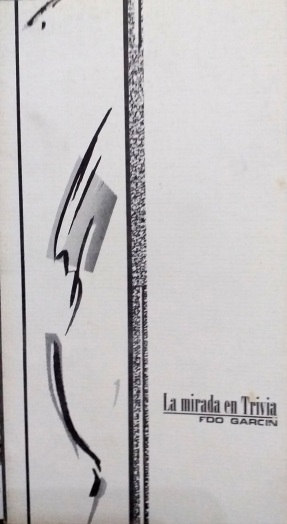
(Portada por Daniel Monzón de «La Mirada en Trivia», poemas de F. Garcin, 1985)
(«Louise» (1986-2016). Horton & Louise’s Uptown Selector (Maloa Warriors & El Fer). Como he contado antes, leí este poema, incluido en Dalmau y La Distancia y la Mirada en Trivia (1985), en spoken word por primera vez en la citada iglesia bizantina de Aradja Imaret en Tesalónica, en la Bienal de Artistas Jóvenes del Mediterráneo en otoño del 86′ donde fui elegido para representar a España. Y 25 años después encontró su música y mi voz a través de Da Boi Derinho y Maloa Warriors. “Aquí hay Ornette, hip hop, avant-garde, sicodelia y experimentación” (Russell Richardson). Vida entre Valencia y USA. «¿Qué será de nosotros si no recordamos? Borracho de tus labios pintados / viajo por las marismas / del confuso amanecer / ¿En qué ciudad serás feliz? /// What will become of us if we dont remember? / Drunk on your painted lips / I travel through the marshes / of the confused dawn / In which town will you be happy? «)
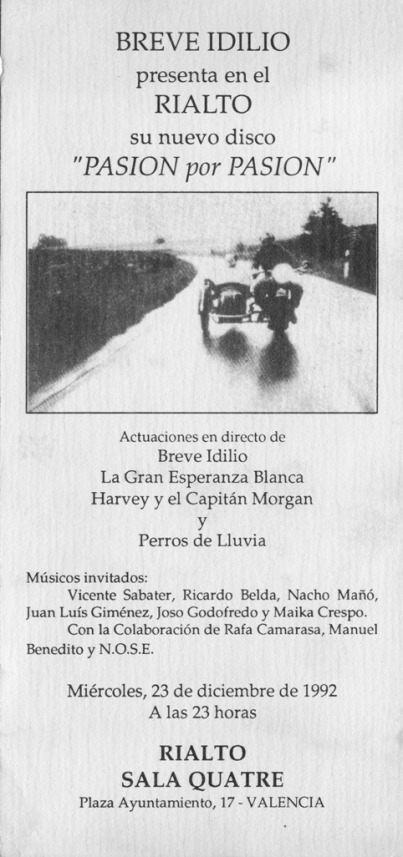
1987-1989. Escribo las letras para el primer disco de Terminal Sur («Viajero», 1988). Algunas letras son de 1986 y 1987 -«Esa Oscura Voz En Off». Otras del mismo 1988. Escribo las estrofas de una canción de Fernando Burgos (Burguitos) y algunas letras más para artistas que me lo solicitan. Al mismo tiempo que termino y publico el libro «Azar Para Dos» (La Gata Loca, 1988) y escribo «Corazón en Peligro» (1989).
Algunas de esas letras y de los poemas de mis libros de 1989 y de 1992 a 1996 los concibo en el Jardín Botánico, y en la Plaza de San Sebastián, donde nacen libros y canciones. El genial Daniel Monzón vive cerca. Él tiene su moto clásica y su amor por ellas, yo llego a tener una Enfield.

Dani solía citar aquella frase de «Valencia no existe». En aquel viaje a Grecia en que compartimos horas y días y risas y asombros, yo reconocí a alguien «especial», una de esos escasos seres a los que puedes llamar «especial» sin que a él le importara. «Conozco sitios peores» me escribió el último día en su dedicatoria del catálogo de la Bienal. En todos los años siguientes, en todo aquel tiempo de alumbrar ingenio en el Botánico, entre la calle Turia y el Carmen, volveríamos a ese humor particular, a trabajar en muchos proyectos de libros y discos donde él dejaba la impronta de su magia genial. Fue un tiempo muy fructífero, entre 1988 y 1996, desde que Dani, Marián y yo solemos quedar allí, hablamos con gatos y magnolios, y creamos en vivo frente a los Jardines, poesía en movimiento (entonces la entrada al Botánico era gratuita) hasta las aventuras editoriales y musicales siempre espontáneas y alejadas del Régimen (sea el que sea el «Régimen», el actual o el anterior, yo no voy nunca con el Régimen. He aprendido de mi madre la independencia y la honestidad, no bailar el agua a nadie ni aprovechar contactos y apellidos o dar obra, ni siquiera cuando hemos estado cara a cara y canapé mediante con el Alcalde o el President).

1989. Otoño. Primera grabación. Cuando entré en el estudio no sentí que estaba grabando. Sentí que estaba interpretando. Todo fluía. Lo mismo sucedió en 2003 con “Tan Fiero Tan Frágil”, con Néstor, Raquel, Jesús…
1989-1995. NOSE. Editora de vinilos Nueva Oleada de Sonidos del Este. La Gran Esperanza Blanca, Inhibidos Quizás. Ceremonia. Armas Blancas, Vicente Sabater, Joso Godofredo, Chuso Almenara, Yolanda Llácer. Los años 1990. La felicidad. La felicidad no requiere de palabras. Ella y su poesía. Breve Idilio. Una década. Risas, cerveza, ojos castaños y motocicletas. Ocres y azules. El nacimiento de la llama. El comienzo del vuelo. Como «Breve Idilio», actuamos en vivo en Cavallers de Neu (26 de enero de 1989 y en el otoño de 1990), en Sala Jerusalén (Otoño, 1989) y en El Rialto (diciembre, 1992) con muchos invitados especiales como «Armas Blancas» (Jesús Fita), La Gran Esperanza Blanca, UHF, Burguitos, Pepe Cantó, y muchos más. La edición de «Nómadas» (1992) por la editorial Nínfula de Barcelona. El origen de mis colecciones editoriales Ediciones de Nunca Acabar y Cuadernos de Cecilia. El decisivo nacimiento de la editorial Diarios de Helena conducida por Jesús Zomeño.

Antes, en 1995, se publica por la editorial a cargo de Jesús Rodrigo Ediciones de La Mirada el libro «El Cantante Mudo» que reúne la poesía de Fernando Garcin hasta la fecha, y presenta al personaje alter ego de Garcín, El Cantante Mudo, dibujado por Jesús Zomeño.

1996. Empieza “La Ronda” -en la semana del 19 al 26 de Octubre de 1996-, pionera Revista Viajera de Poesía y Música que, desde Octubre de 1996 y hasta 1999, actuó por todos los cafés, bares, pubs y asociaciones de Valencia donde se había concebido el libro “La Ronda” (Ediciones Diarios de Helena) -desde el Carmen hasta Ruzafa, desde la Universidad de Valencia o la FNAC hasta Benimaclet- y luego por diferentes ciudades del Estado Español. En aquellas primeras actuaciones de 1996 y 1997 los ensayos eran escasos, apenas un intercambio de sugerencias. Yo llegaba en cada recital con una serie de escritos míos y ajenos, los músicos tocaban y yo iba encajando los textos sobre la marcha. Los textos míos procedían del libro “La Ronda” y de libros previos, y los textos ajenos eran poemas de autores como Miquel Martí i Pol, Pau Riba, Charles Bukowski, Bob Dylan, Leonard Cohen… El “spoken word” era una etiqueta apenas usada y conocida en estos lares. Yo lo llamaba “poetemas”…Los primeros espacios donde actuamos fueron “Cavallers de Neu” con Julio Bustamante (octubre 1996); “Radio City Bar” con UHF (octubre 1996); “Café Lisboa” con Cisco Fran y Edu Marín (octubre 1996); “La Esfera Azul” con UHF, Cisco Fran, Julio Bustamante, Mara del Alar, Maribel Crespo (noviembre 1996); “Perdido Club de Jazz” con la saxofonista Mara del Alar (noviembre 1996); “Café del Temps” con UHF, Maribel Crespo y toda la troupe (4 de enero de 1997).
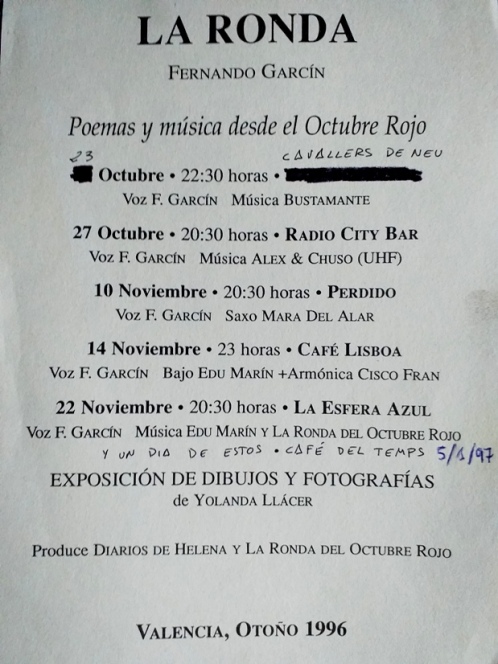
Durante 1997 empiezan a afianzarse temas-canción y, siguiendo con las actuaciones, pasamos en septiembre de 1997 por el Estudio de Grabación de Dani Cardona en Alboraya para registrar una primera tanda de temas… La segunda tanda de temas que compondrían mi primer disco en solitario “La Mejor Hora” se grabó en mayo de 1999. Se continúa con las actuaciones en La Edad de Oro (1997 y 1998), en La Tarara y el Claca (donde se hace un concierto homenaje a Guillermo, gato de Garcin que se va al cielo en 1999), en el Ateneo libertario de Ruzafa, el Kroken, y en dicho 1999 en La Sala de la Muralla del Colegio Mayor Rector Peset de La Universitat de Valencia, y en la Universidad de Verano de Cádiz, entre otras.
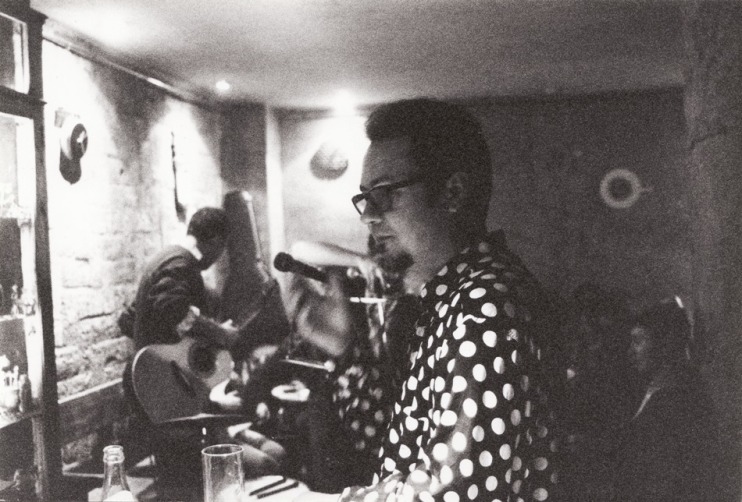
ORIGEN DE «LA RONDA»: En octubre de 1996, Maribel, Marián, Escarlata y yo cogimos el coche y nos fuimos a Roda de Ter (Girona) a buscar la casa de Miquel Martí i Pol, autor del poema “No Demano Gran Cosa”. Me llevé mis 3 tomos de su poesía de Llibres del Mall (1977), comprados en 1978 en la librería Tres i Quatre (1), repleta de notas a lápiz y acordes, como mis libros de Estellés al que conocí en su casa en los primeros 80′. Fue un viaje pensat i fet y muy intenso. Preguntando en el pueblo de Roda de Ter encontramos la casa y allí nos presentamos. Martí i Pol y su mujer fueron extremadamente amables, y el poeta, que padecía una larga y grave enfermedad, estaba encantado de tener la visita del cantante mudo pero sobre todo de 3 chicas tan extraordinarias. Su sentido del humor y su permeabilidad eran deliciosos. Yo quería pedirle permiso para leer en recitales una versión castellana del poema “No demano gran cosa”, y él me dijo “Haz lo que quieras. Las palabras vuelan”. Y hablamos de música, de los ritmos andinos, de poesía, de esto y lo otro…Luego, con su bendición, empezó “La Ronda”, esa Revista Viajera de Poesía y Música… Además de en Valencia y Madrid, actuamos en Alicante y en Cádiz en la Universidad de Verano. Con la organización de mi amiga y traductora Flor Herrero.
(1) Mi abuelo Fernando Romeu, como el resto de la familia Romeu y Alfaro, Sol, mi madre, hija predilecta de la Ciudad por sus 40 años de labor en el Movimiento Ciudadano, sus hermanas Fernanda y Sylvia, sus sobrinos Andreu e Isolda, iban muy a menudo a la librería Tres i Quatre. Recuerdo algunos de esos paseos con mi abuelo Fernando, fiel a la librería hasta el final. Y la publicación por la editorial Tres i Quatre de la historia de “Les Corts Valencianes” de mi tía Sylvia Romeu, quien tiene una calle a su nombre junto a la Plaza del Cedro. También Fernanda Romeu trabaja durante muchos años como historiadora del papel de la mujer en la Guerra Civil y en los Maquis, publicando en editoriales como el Viejo Topo libros esenciales sobre la mujer trabajadora en España y la mujer tras la Guerra Civil, con testimonios de mujeres a lo largo de la geografía española y el extranjero. Su último trabajo se centra en el movimiento pacifista entre la Guerra Civil Española y la Segunda Guerra Mundial.

1997/1998. Barrio de Zaidía. Dani Monzón hacía polaroids e Irene (fotógrafa de la Ronda 96-97), inquilina temporal, dejaba notas cada día en mi piso volador cuando entraba o salía. Mi gato nos miraba extrañado. Le habíamos explicado lo que era un eclipse (¡el último eclipse de luna del siglo!), pero estaba nublado. En el balcón, desde el sofá, un gato majestuoso, una dama exiliada y un pobre trovador observando el eclipse del eclipse. Fue perfecto. Nació mi libro “Eclipse” con poemas que luego serían canciones, como “Mademoiselle” (grabada por Derek Damico en inglés), “Sirius” (grabada por Andrew Austin como “About Wine”) “La Mejor Hora” o “Vieja Carretera”. La frase sobre la polaroid habla por sí sola: “No digas nada, solo sonríe”.



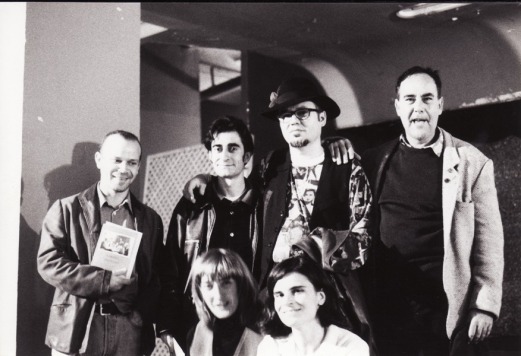

NOTA AL PIE O AL CIELO: De esa «Sonrisa» hay dos referencias en una canción compuesta en 2015, “Sonrisa”, con instrumentación y sonido de Derek Damico, y en otra con instrumentación de Tom Hedrick, “Cada Vez Más Cerca”, dos de las canciones de mi último trabajo «Days Of The Fall» (Sin Detenerse) recién publicado (2019, Bandcamp.)
FERNANDO GARCIN DAYS OF THE FALL. LISTEN AND BUY.
Año 2000. Grabo con Carlos Carrasco en Alhama de Murcia el disco “Vash Gon”. 3 días en una casa de campo en Alhama, con un técnico de sonido de primera y unas canciones muy bien aprendidas. Música exquisita de Carlos, excepto la versión de Dylan de “Tomorrow is a Long Time” que fue, además, la única que grabamos en toma directa. En 1999 había fallecido mi abuelo, mi segundo padre, mi referencia personal, el que me fue cediendo libros a lo largo de los años de incalculable valor de la biblioteca Romeu-Alfaro, antes de que donara los incunables y libros y cuadros y fotografías de gran valor a las Bibliotecas Municipal de Valencia y de la Generalitat (por cierto, creo que soy el único poeta de mi generación que no ha leído en la Biblioteca Municipal de Valencia). Tanto mi abuelo como luego mi madre me han contado sus hermosas historias familiares a partir de fotos, libros o cuadros. Mi abuela de pequeña y Blasco Ibáñez visitando la casa en Godella, la relación con José Iturbi y Amparo Iturbi, profesora de piano de mi abuela. Mis abuelos y el hermano mayor de mi abuelo, Vicente Alfaro, y su breve alcaldía republicana (hasta que se fue de aquí para no volver), sus anécdotas con uno de los primos favoritos, de mi madre, Andreu Alfaro; el trabajo de mi tía Sylvia Romeu en la facultad de derecho con Tomás y Valiente, cómo escribió y publicó su obra de la historia de Les Corts Valencianes. Los libros sobre la mujer trabajadora y sobre los maquis y las mujeres en la españa franquista de mi tía Fernanda Romeu. Los mil recuerdos de Nazaret con todas las generaciones de los Alfaro y los Romeu y los juegos entre primos (Mis canciones con Carlos Carrasco «Hoy Lloviendo hacia la Playa con Suzanne», «Malos Tiempos», así como mi tema «Mañana Tú No Estabas» forman una trilogía de mis recorridos por Nazaret). Y recuerdo bien el porqué mi abuelo me «pasaba» libros de su biblioteca («luego vendrán los bárbaros a arrasar» decía) y así tengo como tesoros la primera edición de «Opio» de Jean Cocteau, firmada por el propio autor con un «Vive la Republique» en 1931, año de la edición, el Proust de Salinas, o la gran biografía de «Charles Baudelaire» escrita por César González Ruano, cuyo prólogo esta fechado en abril de 1931.
(¿Tendría que haber “usado” toda esa filiación familiar para “abrirme puertas” en la Valencia cultural? No lo he hecho. No me van esas cosas. Insignifilandia. Valencia es un accidente. Un error de percepción, que diría mi amigo Dani. Nacemos en un sitio, pero pertenecemos a cualquier lugar donde se nos desbocó el corazón, Si es que pertenecemos a algún lugar. Sí. Soy un subterráneo. Vivo en el Inframundo. No importa si se llama Zaidia, L’Amistat, Combray, Lisboa, Seneffe, Woodstock, Gigha…)

Días mágicos e irrepetibles fueron aquellos en Seneffe (Bélgica) acompañando a mi amiga Flor Herrero a la Residencia de Traductores Literarios en dicha localidad. Un gran rectángulo de casas bajas para alojamiento y actividades en medio de los jardines y bosques de Seneffe, y cerca de su Castillo. Tuve la suerte de conocer a la filósofa feminista Claire Lejuune, a quien Flor traducía su libro «El Libro de la Hermana», y de compartir comidas, cenas y paseos y excursiones con otros traductores, como las estudiantes del Líbano, el traductor irlandés Mark, o el traductor japonés Haki, y la pequeña Lindsay. Mark, Haki, y la propia Flor, tradujeron a sus respectivos idiomas una serie de 3 haikus que había escrito en ese final de siglo. Y ese año de 1999 falleció también mi gato Guillermo, a quien le hicimos un homenaje, con una actuación-festival en la sala Claca (mi agradecimiento infinito a Marián y a Tessa), donde participaron muchos de los músicos y artistas de ese periodo inigualable de música, poesía y arte en Valencia. Un año después, tras un juicio laboral algo penoso, amago de nuevo con dejar Valencia al fin. Extrayendo algo de información en internet sobre rutas, lugares, medios de transportes, alojamientos, en la página de turismo de Escocia, me limité a reservar un vuelo de ida en septiembre y un vuelo de regreso abierto en octubre. Los alojamientos los iba encontrando sobre la marcha y los itinerarios los decidía según los días, excepto el día que fui a ver a Bob Dylan, que actuaba en Glasgow el día de mi cumpleaños, y tocó “Highlands”. Al día siguiente me fui a la estación de trenes y en la taquilla compré un billete para un tren que iba a las Western Highlands. Al cabo de unas horas me di cuenta que el tren se dividía en dos en cierta estación, para emprender dos direcciones diferentes, y me quedé en mi asiento y pensé “adonde vaya”. Estuve en muchos lugares donde me trataron muy bien (excepto una noche en un local de Oban donde una joven pareja española –los únicos españoles con los que me topé en un mes- pasó de mí como si fuera un apestado). En Aberdeen estuve en un café de micros abiertos. No sé si fue allí donde escuché y aprendí “Eileen Aroon”. Sé que improvisé sobre unas notas un tema sobre John Donne (pero en esos años usaba una grabadora de cassette walkman de mi madre y a veces el sonido era aceptable, y otras veces, como esta, el ruido era irreducible), y un “Hay Días Raros” apañado.
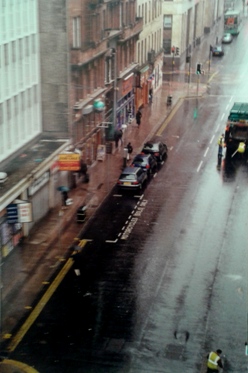
Un día, en el camino entre Glasgow y Taynloan, antes de ir a pasar unos días en la isla de Gigha, que describe John Berger en una de sus narraciones-ensayo, salí por la noche un rato y me encontré con un local con un cartel pizarra que rezaba “Spanish Night” y “Pints 1 pound”. Y allí que me metí, con mi impermeable y mi mochila. Después de agenciarme una pinta y encontrar un lugar donde apoyarme y disfrutar de una batucada, una joven chica rubia se me acercó. “Where’re you from?”. “Spain” I replied. “Oh. We have to dance”. Me hizo dejar el impermeable y la mochila en una silla, me cogió de la mano y para la pista de baile que fuimos. En realidad, la música no era de España, era música latina. Estaba bien. Ella me susurró. “I’d like you translate the words while we’re dancing”. I said: “Ok. This is your spanish knight”. She laughed. Actually I cannot dance quite well, so it was not easy to be telling the words and trying not to tread on her shoes. “You don’t look like spaniard”. “Not really?”. “But it’s fun to hear your voice while dancing”.
Un par de horas más tarde, se fue con unas amigas en un coche, nos enviamos un saludo que no era un adiós. ¿Quién sabe decir adiós?
Tan fiero, tan frágil.

2001-2003.
Empiezo a quedar con Néstor Mir. Creo que nuestra primera conversación fue en Las Arenas, y que él quería que se sacara más de lo que yo tenía dentro, y dar un giro de tuerca a mi experiencia con la voz y las canciones. Compusimos como posesos, en esos dos o tres años, actuamos en todos los formatos y lugares. Se unió gente que tocaba en su banda, y que son ya mis amigos y colegas artísticos desde entonces. Jesús Maestro, Raquel G. Fas… Se unió a esa troupe Juan Carlos “Xarli” Sanjuán, que vino a una actuación en 1999 en la FNAC y desde entonces es mi compañero-hermano. El que siempre llama. El que comprende. El que usa todavía el teléfono para hablar cuando ya nadie lo hace, si vernos no es posible. En cuanto a Néstor, las canciones brotaron una tras otra, en estado de gracia, y después de dos actuaciones estelares en el Festival Caleidoscópics de 2001 y 2002, fuimos a grabar los tres primeros días de Julio de 2003 en el Estudio de Dani Cardona, cuando en la calle la temperatura rozaba los 40 grados. Después del tiempo de sonorización, grabamos de una sola tirada, en directo, 9 canciones, en una mañana. No hay ni un solo pinchazo (al igual que no lo hay en “La Mejor Hora”). Primeras tomas, a fuego; íbamos muy rodados. Solo se agregaron después los instrumentos que no se podían grabar en directo, porque eran solos de eléctrica, de Néstor y de Jesús, o teclados de Maribel. Con Raquel sucedió algo desde 2002 que ya no ha cambiado. Es una de las grandes voces femeninas de este país, pero además la sincronización con mi voz y mi visión de una canción es inmediata, natural. A veces no hay que hablar apenas.

No puedo olvidarme de Madrid. De Sonsoles, Antonio, Valentín, Manolo, Flor… Actuamos muchas veces entre 1999 y 2005 y siempre fueron actuaciones intensas y llenas de complicidad y de un público arrebatado. Un paraíso. «Hazte un peta-lo». La magia de Madrid. El Lucky Bar. Nuestro 221B.

En 2004 empecé a asistir como alumno a Catarastrofeatro, en Campanar. Estuve 2 años aprendiendo de los mejores, Jorge, Christophe (Christophe Morin grabó mis canciones «El Mundo Está Marujo» y «La Tortuga Que Sueña»), Pedro Aznar (con quien grabé «The Second Rain»), y mis compañeros Iván Arguedas y Jordi Marquina (con quienes mantengo una gran amistad). Un día Iván y yo hicimos una representación de final de curso de cazadores de murciélagos mutantes. Más adelante he hecho algunas colaboraciones con Jordi Marquina, ese gran actor, ilustrador, clown y cómico con quien compartimos la admiración por Buster Keaton, Gila y Poncela, así como por los tutús y los yoyós. Entre 2004 y 2006 hice con Néstor algunas grandes canciones en un momento complicado. Podríamos haber seguido, pero era tiempo de parar. Esas canciones se incluyeron, en parte, en la gran edición de Carlos Carrasco para Comboi Records “Tiempo y Detalles”. Las que no fueron incluidos en ese disco, lo fueron en mi penúltimo disco, “Amor sin Título” (Untitled Love), que grabé con ayuda de Javier García Sevilla en 2011. Un disco sin banda, grabado por partes con las aportaciones de Javier y de Carlos y algunos músicos invitados. El primer disco en que la mayoría de las canciones de la “cara A” estaba compuestas por mí y las cantaba más que recitaba. «Claire In The Shade», «Noche Bajo El Sol», «Airport Song»….
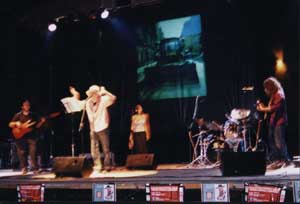
2009. Lo más hermoso del bello viaje a Woodstock fue reencontrarme con mi viejo amigo Russell Richardson, y comprobar que seguíamos donde lo dejamos pero más viejos, y que al interpretar con él en directo (guitarra eléctrica y voz) “La Mejor Hora” y «Nada Se Pasa A Limpio» era como si lo hubiéramos hecho toda la vida; conocer a Dorota Czerner, la reina del agua y del fuego, su ternura y humanidad y su talento literario e interpretativo; y a su talentoso hijo Robin, a quien ya había conocido un tiempo antes en Barcelona donde fue premiado por un corto de animación. Y al cuarto o quinto día, darme cuenta de que aquel hombre sabio y discreto al que llamaban Ben, era nada menos que el gran compositor y teórico de la música Benjamin Boretz (me lo dijo Russell sentados en un restaurante, y yo me giré hacia Ben y no supe bien qué decirle a alguien que además, como decimos en España, es una bellísima persona, a really good man). Por supuesto me sorprendieron los inmensos paisajes, las grandes distancias, la amabilidad de todos los habitantes, la hospitalidad, los desayunos con Carlos en el Bread Alone, el encuentro con los amigos artistas o alumnos de Russell y Dorota. Actuar en Woodstock -en ssu Ayuntamiento y en el Red Barn- era un sueño, y sin embargo en aquel momento de la actuación me sentí en casa, y estuve cómodo y sin nervios.

2014.
Sin Detenerse. Days Of The Fall.
Las canciones se escriben cuando uno está en movimiento. Al ir a sacarse sangre. De regreso de una batalla burocrática, en el autobús, con papel y bolígrafo. De madrugada, cuando empieza a clarear, y con una sensación de “eco de piel”, de labios que recuerdan besos en el vacío. Hay que trabajar, sí. Pero sin ser uno con el tiempo, sin estar haciendo tiempo, sin ver lo que otros no van a ver, sin todo eso no hay canción ni poema. Puede ser que todo surja en unos minutos, o puede ser que tarde días, o semanas. Lo importante es ser fiel al misterio. Dejar que la musa te atraviese como un escalofrío antes de alimentar el cuerpo o tomar la medicación. Niños jugando. Entonces y ahora. Niños jugando, de eso va todo. Chapotear…
Hay canciones como “Llévame al Huerto”, “Sin Detenerse”, “Song For You”, “Sonrisa”, “Digno Arte”, “Cada Vez Más Cerca», “Diablo Que Espera” o «Diana & Robin» que nacieron así. En la confluencia inasible del tiempo pasado y el tiempo futuro. En la marcha apenas detenida. (De Diana & Robin hay una versión libre grabada por el gran cantautor de Tampa, Florida, Mike Baluja, que también ha grabado una canción dedicada a mi trabajo de trovador: «The Great Garcin» y más recientemente ha hecho una magnífica versión en inglés de mi tema «Mañana Tú No Estabas» -‘You were not there tomorrow’-)
SONG FOR YOU. “Cuando pronunciaste las palabras ‘falta un minuto para que me vaya y me pregunto si nos volveremos a ver’ y te detuviste en una gasolinera para comprar bebidas frías y el encargado nos dijo que teníamos que usar los guantes de látex y nos reímos como locos otra vez como lo habíamos hecho en el viejo sofá abandonado en nuestra tierra de nadie, era la primera ola de calor del verano y supimos que nos veríamos de nuevo algún día antes de la primera glaciación”
SIN DETENERTE. Era uno de esos días de calor asfixiante, en los que resulta difícil respirar. Incluso al caer la noche me sentía mareado y sin fuerzas. Fue entonces cuando pasaste corriendo por mi lado y dejaste ese halo de brisa a tu paso que me hizo escribir: “¿Puedes pasar deprisa otra vez por mi lado sin detenerte?”. Tenía que ser una canción con ritmo vivo y cierta alegría, entre el La y el Si, una danza frente a los días con muros. Tú, que puedes relajarte hasta fundirte con el tiempo que eres y perder la noción de las horas, en otras ocasiones eres rauda y veloz, y desapareces de la vista antes de que me pueda dar cuenta. Quería hablar de ti en algunas estrofas, de cómo corre la vida por tus venas y cómo sientes las cosas que otros ni siquiera ven. El tiempo en sí mismo, la gente que pasa por la vida sin mirar atrás, siempre hacia adelante. ‘Sin Detenerse’ sería un gran título para ti”, dijiste un día.
Post Scriptum: si de un poema en prosa se tratara, escrito, como Goethe decía en Eckerman, cual jarro de agua vertido en el momento, quizá esté de más explicar lo que es misterio que cada uno pueda interpretar a su gusto y según su sentir. El misterio es la revolución, la pobreza, el tener a alguien que pasa por tu lado y te ofrece su brisa al pasar como ventilador efímero.
SONRISA. A veces (muchas) no puedo dormir por la noche y esta canción trata de una chispa humana que vi meses atrás –de vez en cuando me encontraba con ella por la calle o en callejones oscuros – nos sentamos y charlamos o damos una vuelta y ella me cuenta lo difícil que es buscarse la vida en estos tiempos y todas las cosas que tiene que hacer para sobrevivir – yo no juzgo, solo escucho – si eres de los que juzgan entonces no sigas leyendo, no eres de los nuestros – ella me habla también de lo complicado que es saber lo que uno quiere hacer en esta vida o saber cuál es el propósito de estar en este mundo – – Le cuento que algunas de las personas más interesantes que he conocido no sabían, y siguen sin saber, lo que hacen exactamente aquí, ni siquiera los más mayores – Ella sonríe pero no se siente impresionada – conoce cosas que yo nunca aprendí a su edad – compartimos lo que tenemos, una cerveza, una bebida fría, una porción de pizza, y eso es todo – Una de aquellas noches paseamos durante una hora o quizá hasta la madrugada – en un momento dado sintió ella que era el momento de irse y nunca decimos adiós, simplemente nos vamos cada uno por su lado deseándonos suerte… Esa misma noche o quizá unas noches después iba por ahí buscando algo de música y bebida fría y me quejaba de lo rápido que pasa el tiempo y cuánto de ese tiempo nos lo pasamos esperando un breve instante de gozo. Ese día estabas quieta, a mi lado, pusiste suavemente tus manos en mis labios como para taparme la boca y dijiste: “Niño. No te preocupes tanto. Somos el tiempo que nos queda.”
2019. Escribí las canciones de “Days of The Fall” (Sin Detenerse) entre 2013 y 2015. Escribí hasta 2017 más de 20 canciones. Y dos libros de narraciones. Y un libro de poemas. Las canciones se grabaron en 2016 y en 2017 se terminó la grabación y se hizo el master. Entonces algo sucedió. Hasta 2019 no se pudo publicar el disco. Ahora somos todos personajes en los brazos del Tiempo. Ella no está. Está la distancia, si se puede salvar, y está el tiempo, atizando las brasas, si se pueden salvar. Es ese momento. Aullar o el silencio. Paseos y bailes, dormir y despertar a la velocidad de los vientos en Urano.
© Fernando Garcin, 2019-2022.
ENGLISH VERSION
I NEVER HAD A PLAN. 1.
(sketches from memory)
““Everything is written according to the impression of the moment; no general artistic plan has been thought of; it is like when a jug of water is spilled.”(Goethe, Eckermann, 1823)
«On ne reçoit pas la sagesse, il faut la découvrir soi-même après un trajet que personne ne peut faire pour nous, ne peut nous épargner.»/ «We are not provided with wisdom, we must discover it for ourselves, after a journey through the wilderness which no one else can take for us, an effort which no one can spare us.”
(Marcel Proust)
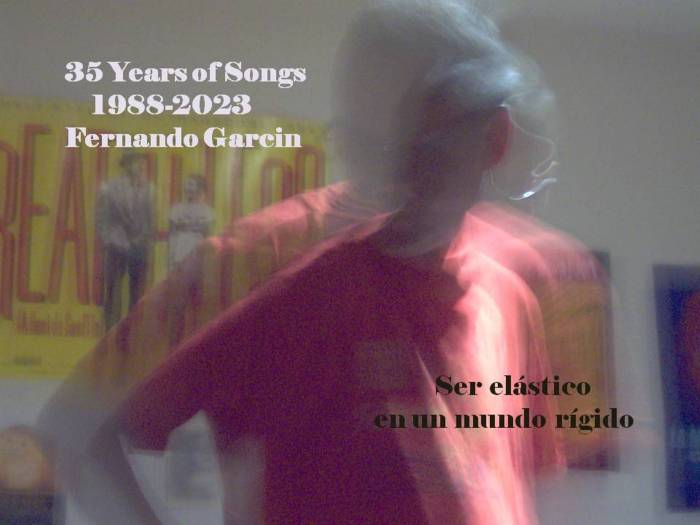
It was winter. Circa 1971. I look at the photo. We organized a performance at my aunt and uncle’s house, near what is now called «El Cedro». The oldest was me with about 10 years old and a microphone. My cousin Carles on drums. My sister Sole and my cousin Eva on guitars. The smallest ones dancing. About those same years, a summer in Siete Aguas, where my grandparents had the house «Alquería dels Romeu», we organized a play or performance based on the Great Dictator. I’m disguised as a Soldier with a Hitlerian mustache, while my cousin Carles is dressed as a Native American. We knew that the one with the mustache was not going to win. Children playing. That’s all about. Then and now.
My father passed away when I was 15. Between 1974 and 1978 changes are like mutations. The Secondary School was one of my paradises. A new circle of friends loomed on the horizon. In that period the avid curiosity made me what I am. The eclecticism, no labels, no definitions, the lack of rigidity, the open mind, the sponge that absorbs everything without prejudice. Before 1981, I read Marcel Proust, Thomas De Quincey, Antonio Machado, Miquel Martí i Pol, Estellés, Dylan Thomas, Jean Cocteau, Julio Cortázar, Jack Kerouac, Nietzsche, Oscar Wilde, Montserrat Roig, Carson McCullers … I listened to rock, classical, jazz, blues, folk music, punk, new wave … Jacques Brel, La Rondalla de La Costa, Aragonese jotas, Patti Smith, Beethoven, Ian Dury, Kurt Weil, Lou Reed, Pau Riba, The Clash, Turkish and Balkan traditional music, Reggae, Ska, Sisa, Kevin Ayers, Bob Dylan, Leonard Cohen, Jordi Sabatés, the progressive breath of Dioptria, Smash, John Cale, Neil Young, punk, Barbara, Frank Sinatra, Bola de Nieve, Thelonious Monk, Dizzy Gillespie … I got soaked by Buster Keaton, Wim Wenders, Max Ophuls, Victor Erice, John Ford, Godard, Chaplin, Fritz Lang …
( I’m late as usual. I weird kid -12yrsold- asked my mom to take me to an old shop they had some tapes and bought first Another Side of Bob Dylan in 1972. 2 years later Planet Waves and The Basement Tapes. Later, after age 15, my grandfather would come with me sometimes, as my mom was really busy. It was a rare shop they had fans for summer, lamps, heaters and gas cookers, blankets, and tapes and some vinyls. I also bought some jazz music (“Cherokee” by Clifford Brown, con John Lewis, piano, Percy Heath, bass, Art Blakley, drums – also «It Never Entered My Mind» by Miles Davis on trumpet and Horace Silver on piano) and Rory Gallaguer’s Tattoo Lady and folk music from valencia & aragon and Brel and Quadrophenia and T-Rex, (“A Beard of Stars”), psychedelic stuff and Pink Floyd and Pau Riba & OM, and Vampyria and The Band and later The Who and The Kinks – ah ‘I’m like anybody else’, ect, and blabla… my monthly allowance was about 5 bucks. Rayuela and Sherlock Holmes and Tarzan and Philip Marlowe, I’m not going to talk about the past because I’m la Malvarrosa, she is Las Arenas, we don’t need to go further than that to talk about poetry or music, life, joy, darkness, or whatever art it is because we met the poet and the voice many years ago before the flood and they were passing and they gone and they are coming and going and we knew that well. “Sol, Solet…”)

Everything that has come after has been a beautiful addition, a continuing to learn along the path of constant search.
In 2005 I started a blog called «The Second Rain». I write and review on everything. Artists, friends, anonymous people, memories. Until this day, the overwhelming amount of posts amazes and congratulates me. In 2015 I started another blog called «Labellezaesnodetenerse» which is something like a «fernipedia». Portraits of past and current artists that I admire. For now there are 12 entries on women and 11 on men. There is no rhythm or frequency, except from my heart and appetite. And then there are these whimsical memories, integrated with alot of images in this blog called: «noteolvidesquenomeacuerdo».
Between 1979 and 1983 I made my first recitals with music. Already with the company of Uberto Stabile, Clara Beltrán, and many other colleagues, I tried to introduce into our environment the spontaneous and persevering spirit of Kerouac, Thomas and others. The days and nights «on the road», through the Spanish geography. I remember a trip to Cádiz in Uberto’s car around 1980 (later I would return to Cádiz in 1999 with the troupe to perform at the Summer University) when we stopped at several places to rest, one of them was in Guadix. There was a street market in the Plaza, and I went to a toys stand and asked the young girl I wanted to buy a rattle. There were blues and pinks. I told her I wanted the pink one. She said that blue was more of a boy. But I kept the rose and she smiled. I used that rattle to accompany me in some poetry performances, I don’t know if with “El Rey Escarlata”, «Valencia Nit Blues» or any of those early poems.

1986. The year of the Critic’s Circle Award and of being chosen to represent Spanish poetry in the biennial of young artists from the Mediterranean, in Thessaloniki, Greece. One day in November in Greece with the great graphic artist Daniel Monzón, whom I met on that trip. We are sitting in a couple of chairs at one of the evening’s events. Something seems to go wrong on stage. A fight of egos, it seems. The City Council had assigned us as a guide for the trip to a stuttering official, one of those heroes of the «other politics» without which the politicians would only be the falsehood that it is. He found the fliscorno that we lost (from the group Ball A Banda) at the airport (it was not easy to explain to the Greek customs officials what it meant to have lost a fliscorno, or, simply, that it was a musical instrument). He got us extra accommodation and food when, after the biennial, we had to stay one more day without a flight and abandoned to our fate. The fact is that night he approached the place where Daniel and I witnessed the performances, and he told us: «These Greeks are out of mind.» It just happened that they spoke very loudly, and they seemed angry. But they were very good people. As the representative of Cyprus, the representative of Greece, the representative of Portugal … only a squeaked thing came from a few of the egos of the Catalan representatives, who looked over their shoulders, and some Italians (after all, they had an entourage of well dressed managers and they took care of the marketing until the insufferable). My only artistic intervention in the Biennial was a recital in a Byzantine church. One of the most beautiful places in which I have performed my poems. As the organization hadn’t split rockets (probably for lack of means and money) there was no simultaneous translation, and some other poets decided not to recite after giving an explanation. Just when entering the church, talking to Daniel and the musicians from Ball A Banda, a woman spoke to me in Spanish. He was Argentine although he was living in Thessaloniki for many years. The fact is that we went down to the catacombs of the church, and I explained her what I was going to read, and she took notes. Before my performance she went out to speak in greek, and facilitated my entry. The fact is that the hundreds of people in the audience applauded in rage. I read my poems «Louise», «Coltrane», «Maquillaje», «Rey Escarlata» … Other poets also wanted to recite, despite the inconveniences, the charming young Portuguese woman, who did it barefoot and with the support of a piano, the young woman poet from Cyprus, with whom I connected from the first moment, and the Italian representative.
(«Louise» (1986-2016). Horton & Louise’s Uptown Selector (Maloa Warriors & El Fer). As I told before, I read this poem the very first time -spoken word style- in the Aradja Imaret Church in Tessaloniki (Greece) at the metioned Festival of Young European Artists in which I was chosen to represent my country. Almost 25 years later the words met its music and my voice. Da Boi Derinho y Maloa Warriors. “Ornette, hip hop, avant-garde, psychedelic sounds and experimental” (Russell wrote). Life. Music. Valencia-USA.)
1988. I wrote the lyrics for the first album of Terminal Sur («Viajero», 1988). Some lyrics are from 1986 and 1987 («Esa Oscura Voz En Off»). Others from the same 1988. I wrote the stanzas of a song by Fernando Burgos (Burguitos) and some other lyrics for artists who requested my words. At the same time I finished and released the book «Azar Para Dos» (La Gata Loca, 1988) and wrote «Corazón en Peligro» (1989). Some of those lyrics and the poems of my books were written in the Valencia’s Botanical Gardens, and in the Plaza de San Sebastián, in front of the Gardens. Daniel Monzón was living nearby. Dani, Marián and I used to meet there, talk to cats and magnolia, and create live performances. Then the entrance to the Botanist was free. There were quite spontaneous. In this XXI Century the artistic and musical events are activities of the Regime (whatever, current or previous ones the Regime might be, I never have been part of -just like I learnt from my mom, no matter how close we are talking to a major or president…)
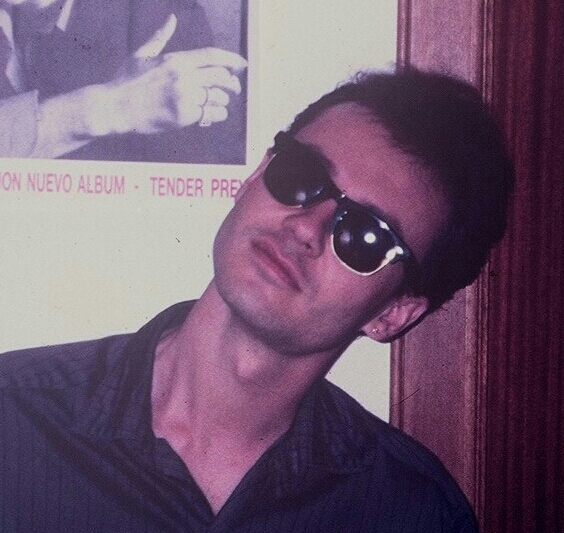
1989. Fabruary. First studio recording in my life. When I got in the studio I did not feel like I was recording. I felt that I was performing. A “interpreter”. Everything flowed. The same happened in 2003 with «Tan Fiero Tan Frágil», with Néstor, Raquel, Jesús…
1989. The 1990s. Happiness. Happiness does not require words. She and her poetic hands. Breve Idilio. One decade. Laughter, beers, brown eyes and motorcycles. Ocres and blues. The birth of the flame. The beginning of the flight. We, as «Breve Idilio», performed live at Cavallers de Neu (January 26th 1989 and autumn 1990) and Sala Jeresulalen (Autumn, 1989) and Rialto Theatre (december 1992) with a lot of very special guests like «Armas Blancas» (Jesús Fita), La Gran Esperanza Blanca, UHF, Burguitos, and many more.

1996. “La Ronda” began its journey, a rolling review of poetry and music performing with different musicians, in many different places, bars, pubs, cafés, bookshops and schools. When it began we hadn’t real rehearsals, just some conversations and ideas. The musicians that might come for every gig just played its music and I began to fit words and find ranges and tones of delivery. Every day and gig the poems might be different, poems of mine or poems by other writers, like Miquel Martí i Pol, Charles Bukowski, Pau Riba, Bob Dylan, Leonard Cohen… “Spoken word” was a label few people knew in Spain so I didnt give a name to what we were doin’ or just I’d have called that “pometunes” since 1997.
Before the first show took place this is a story about what happened 2 weeks before and a remembrance of the great poet from Catalunya Miquel Marti i Pol. I visited him in 1996 before my kind-of Rolling Review “La Ronda” (1996-1999). He was one of the poets who influenced me when I was a kid and I went to Roda de Ter, the village he was living in, with my friend Maribel and her little daughter Scarlata (3 years old then) and my girlfriend Marian. We drove many miles from Valencia to meet him. When we got there we asked for his house. He and his wife were so kind and beautiful. He suffered for years a serious illness he couldn’t move. He had a great sense of humour and was fascinatined we four were there. I asked him permission for using one of his poems -“No Demano Gran Cosa”- during the first shows of La Ronda, and he said: “Do what you want to. Words fly”. Then “La Ronda” started with a troupe of musicians playing all months in different places. In addition to Valencia and Madrid, we perform in Alicante, Barcelona and Cádiz at the Summer University. With the organization of my friend and translator Flor Herrero.

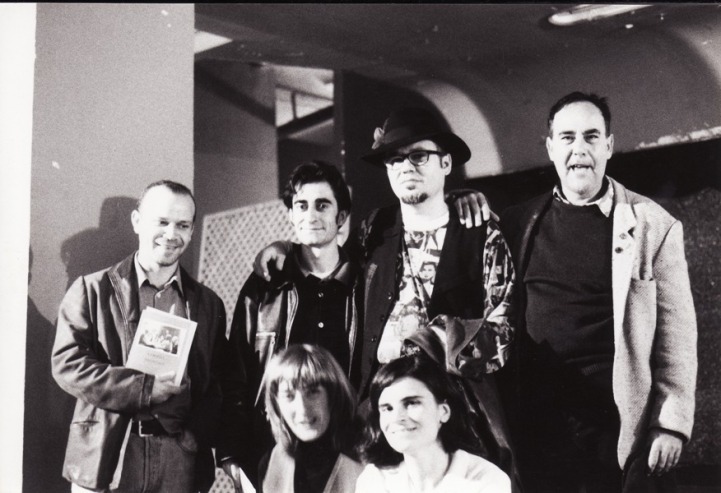
2000. I recorded with Carlos Carrasco in Alhama de Murcia the album «Vash Gon». 3 days in a country house in Alhama, with a first-class sound technician and some very well-learned songs. Exquisite music by Carlos, except the version of «Tomorrow is a Long Time» which was also the only one we recorded live together. In 1999 my grandfather had passed away, he was my second father, my personal reference, who gave me books over the years of incalculable value from the Romeu-Alfaro library, before he donated the incunabula and books and paintings and photographs of great value to the Municipal Libraries of Valencia and the Generalitat (by the way, I think I am the only poet of my generation that has not read in the Municipal Library of Valencia). Both my grandfather and then my mother have told me their beautiful family stories from photos, books or pictures. My grandmother as a child and Blasco Ibáñez visiting the house in Godella. My grandparents and my grandfather’s older brother, Vicente Alfaro, and his brief republican mayoralty (until he left here not to return), my mom’s anecdotes with one of her favorite cousins, Andreu Alfaro; the work of my aunt Sylvia Romeu in the law University of Valencia with Tomás y Valiente -killed by ETA-, how she wrote and published her work about the history of Les Corts Valencianes. The thousand memories of Nazareth and the games between cousins (My songs «Lloviendo con Suzanne», “Malos Tiempos” from my unique record with Carlos Carrasco music “Vash Gon”, as well as “Mañana Tú No Estabas» from “Tiempo & Detalles” are like a trilogy of my walks through Nazaret); the reason why my grandfather passed me books from his library (‘ then the barbarians will come and wipe out everything’ ’ he said) and thus I have as treasures the first edition of» Opium «by Jean Cocteau, signed by the author with a» Viva La Republique «in 1931, year of the edition, or the great biography of «Charles Baudelaire» written by César González Ruano, whose prologue is dated April 14th 1931.

(Should I have «used» all that family affiliation to «open me doors» in cultural Valencia? I have not done it. Those things are not my thing. Valencia is an accident, a mistake of perception, as my friend Dani would say, we are born in one place, but we belong to any place where our hearts shined, if we belong somewhere. I’m a subterranean. I’m in the underworld. It does not matter if it’s called Zaidia, Nazaret, Combray, Lisbon, Seneffe, Woodstock, Gigha …)

1997/1998. Dani Monzón made polaroids and Irene, temporary living in my house, used to left notes everyday on my flying table when she came in or left the flat. One day my cat looked at us strangely. We had explained him what an eclipse was (it was the last lunar eclipse of the century!), But it was cloudy. So there we were, a majestic cat, an exiled young Lady and a pour troubador sitting on the blue couch looking at the eclipse of the eclipse. Just perfect. My book «Eclipse» was born with poems that would later be songs, such as «Mademoiselle» (recorded by Derek Damico in English), «Sirius» (recorded by Andrew Austin as «About Wine») «La Mejor Hora», “Vieja carretera»or the unpublished “In The Red”. The phrase about the polaroid speaks for itself: «Don’t say anything, just smile.» From that «Sonrisa”» there are two songs composed in 2015, with instrumentation and sound of Derek Damico, and “Cada Vez Más Cerca” with instrumentation by Tom Hedrick, two of the songs of my new work «Days Of The Fall» (Sin Detenerser) recently published (2019, Bandcamp.)
FERNANDO GARCIN DAYS OF THE FALL. LISTEN AND BUY.

Magical and unrepeatable days were those in Seneffe (Belgium) accompanying my friend Flor Herrero to the Residence of Literary Translators in that town. A large rectangle of low houses for accommodation and activities in the middle of the gardens and forests of Seneffe, and near its Castle. I was lucky enough to meet the feminist philosopher Claire Lejuune, to whom Flor translated her book «The Sister’s Book», and to share lunches, dinners and walks and excursions with other translators, such as the Lebanese students, the Irish translator Mark , or the Japanese translator Haki, and little Linday. Mark, Haki, and Flor herself, translated into their respective languages a series of 3 haikus that I had written at the end of the century.
And that year of 1999 my cat Guillermo also passed away, to whom we paid tribute, with a performance-festival in the Claca Bar (I always will be eternally thankful to Marian and Tessa), where many of the musicians and artists of that unparalleled period of music, poetry and art in Valencia participated and performed. In addition, I had gone through a tough judicial trial due to illness at work. So extracting some information on the internet about routes, places, ways of transport, accommodation, on the tourism page of Scotland, I just booked a one-way flight in September and a return flight in October. I found the lodgings along the way and the itineraries were decided according to the days, except the day I went to see Bob Dylan, who played in Glasgow on my birthday, and he played «Highlands». The next day I went to the station and at the ticket office I bought a ticket for a train that went to the Western Highlands. After a few hours I realized that the train was divided into two at a certain station, to undertake two different directions, and I stayed in my seat and thought «where I go it’ will be ok». They treated me very well, so kind, in all places (except one night in a local in Oban where a young spanish couple ignored me as if I were a plague). In Aberdeen I was in a cafe with open mics (thanks Mark). I do not know if it was there where I finally learnt «Eileen Aroon». I know that I improvised on some notes a song about John Donne (but in those years I used my mother’s Walkman cassette recorder and sometimes the sound was acceptable, and other times, like this one, the noise was irreducible) and one «Hay Días Raros» short performance.
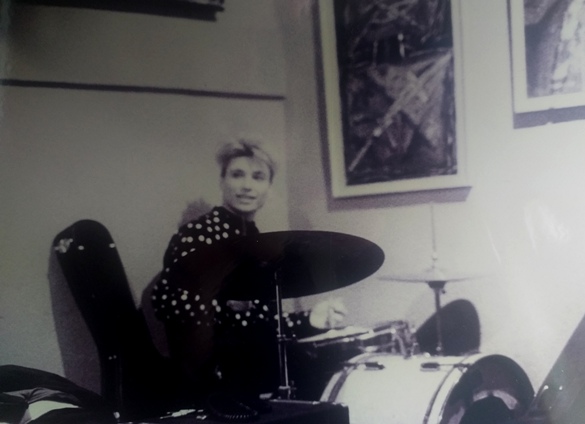
One day, on my way from Glasgow to Taynloan, before going to spend a few days in the island of Gigha, which describes John Berger in one of his essay-narrations, I went out at night for a while and found a place with a blackboard sign in which I read «Spanish night» and «Pints 1 pound». And there I got, with my raincoat and my backpack. After getting a pint and finding a place to lean on and enjoy a batucada, a young blonde woman approached me. «Where’re you from?» «Spain» I replied. «Oh. We have to dance!”. She made me leave the raincoat and the backpack on a chair, he took my hand and for the dance floor we went. Actually, the music was not from Spain, it was Latin music. It was good. She whispered to me. «I’d like you to translate the words while we’re dancing.» I said: «Ok. This is your spanish knight”. She laughed. Actually I can’t dance really well, so it was not easy to be telling the words and trying not to tread on her shoes. «You do not look like spaniard». «Not really?» «But it’s fun to hear your voice while dancing».
A couple of hours later, she left with some friends in a car, we waved a farewell that was not a goodbye. Who can say goodbye?
«Tan Fiero, tan Frágil.»

2001-2003. I start to meet with Néstor Mir. I think our first conversation was in Las Arenas, and he let me know he wanted to get more out of what I had inside, and give a twist to my experience with voice and songs. We composed as possessed, in those two or three years, we made shows in all formats and places. People who played in his band joined us, and some of them are already my friends and artistic colleagues since then. Jesus Maestro, Raquel G. Fas … Juan Carlos «Xarli» Sanjuán joined this troupe too, he who came to a performance in 1999 at the FNAC and since then is my brother-companion. The one who always calls. The one who understands. The one who sees what I see. The one who still uses the telephone to talk when nobody else does anymore, when meeting in person is not possible. As for Néstor, the songs sprouted one after the other, and after two stellar performances at the Caleidoscopic Festival of 2001 and 2002, we went to record the first three days of July 2003 at the Studio of Dani Cardona, when on the street the temperature was 40 C degrees. After the check-sounding time, we recorded 9 songs in one morning, live. There is not a single puncture (just like there is not in «The Best Hour»). First takes live, on fire. We had been playing the songs for months. Only the instruments that could not be recorded live were added later, because they were solos of electric guitars, by Néstor and Jesús, or keyboards by Maribel. If I have to write about Raquel G. Fas something happened since 2002 that has not changed. She is one of the great female voices of this country, but also the synchronization with my voice and my vision of a song is immediate, natural. Sometimes we don’t even have to talk.
I could not forget Madrid. Sonsoles, Antonio, Valentín, Manolo, Flor … We performed many times between 1999 and 2005 and were always intense and funny gigs so full of complicity and wih a raptured audience. Paradise. The Lucky Bar. Our 221B.
In 2004 I started attending the theater Catarastrofeatro as a student in Campanar. I spent 2 years learning to act on stage from the best teacher Jorge, and from Christophe (Christophe Morin recorded my songs «The World Is Marujo» and «The Turtle That Dreams»), Pedro Aznar (with whom I recorded «The Second Rain»), and my companions Iván Arguedas and Jordi Marquina (with whom I maintain a great friendship). One day Ivan and I played a theatrical clown performance: «mutant bat hunters». Later I have made some collaborations with Jordi Marquina, that great actor, illustrator, clown and comedian with whom we share the admiration for Buster Keaton, Peter Sellers, Gila and Poncela, as well as for tutus and yoyós
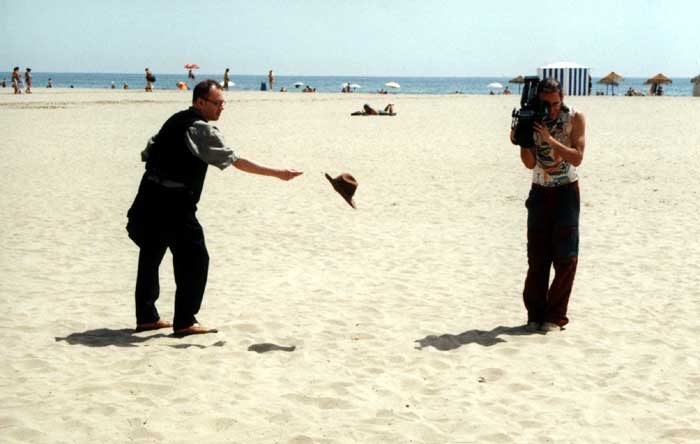
2009. The most beautiful thing about the wonderful trip to Woodsctock was to meet my old friend Russell Richardson, and check that we were the same comrades we were in 1986 but older, and that when I played live with him (electric guitar and voice) «La Mejor Hora» it was as if we had done it all our lives; to meet Dorota Czerner, the queen of water and fire, her tenderness and humanity and her literary and interpretive talent; and his talented son Robin, whom I met a while earlier in Barcelona where he was awarded for an animated short. And on the fourth or fifth day, I realized that the wise and discreet man they called Ben was nothing less than the great music composer and theorist Benjamin Boretz (Russell told me that while sitting in a restaurant, and I turned to Ben and I didn’t know what to say to someone who also, as we say in Spain, is a beautiful person, a really good man). Of course I was surprised by the immense landscapes, the great distances, the friendliness of all the inhabitants, the hospitality, the breakfasts with Carlos at the Bread Alone, the meeting with the artists and student friends of Russell and Dorota. Performing in Woodstock was a dream, and yet at that moment of the performance I felt at home, and I was comfortable and without feeling nervous. (See photo above of Russell Richardson and I performing in The Red Barn, Woodstock. April, 2009).

Then between 2004 and 2006 I made some great songs with Néstor at a time that was difficult. We could have followed, but it was time to stop. These songs were included, in part, in the great edition of Carlos Carrasco for Comboi Records «Tiempo y Detalles». Those that were not included in that album, they were in my penultimate album, «Amor sin Título» (Untitled Love, 2011), that I recorded with the help of Javier García Sevilla in 2011. A record without a band, recorded in parts with the contributions of Javier and Carlos and some guest musicians. The first album in which most of the songs of the «A Side» was composed by me and I sang them more than I recited.
Sin Detenerse. DAYS OF THE FALL. 2019.

The songs are written when one is in movement. When going to draw blood. Back from a bureaucratic battle, on the bus, with paper and pen. At dawn, when it starts to clear, and with that kind of «skin echo» sensation, of lips that remember kisses in a vacuum. You have to work, yes. But without being one with time, without making time, without seeing what others are not going to see, without all that there is magic, no song or poem is possible. It may be that everything comes up in a few minutes, or it may take days, or weeks. The important thing is to be faithful to the mystery. Let the muse passes through you like a chill before feeding the body or taking the medication. Once again, all is about playing. Children playing. Then and Now. Children splashing in the water.
There are songs like «Llévame al Huerto» («Lead me on to the Garden Path»), «Sin Detenerte», «Song for you», «Sonrisa», «Digno Arte» (Worthy Art), «Diablo Que Espera» or»Diana & Robin» that were born that way. In the ungraspable confluence of past time and future time. Along the way, barely stopped. (From Diana & Robin there is a free version recorded by the great singer-songwriter from Tampa, Florida, Mike Baluja, who has also recorded a song dedicated to my work as troubadour: «The Great Garcin.»)
«The Great Garcin» by Baluja
SONG FOR YOU. I remember I wrote this after the last day we met: «When you said the words «just a minute before I leave and I wonder if we’ll meet again» and then you stopped at a gas station to buy cold drinks and smoke and the stoke clerk told us we had to use latex gloves and we laughed again as we did at the old sofa in our brownfield land, it was the first heat-wave of summer and we knew we’d meet again someday before the very last glaciation.»
SIN DETENERTE. It was one of those days of extreme heat it was really hard to breathe and I was feeling sick even when the night was falling out and then you passed by my side quickly and you left a breeze behind and I wrote that line: ‘could you please come by my side again quickly without stopping?’. It had to be a bright rhythm song showing joy, between keys A and B, a dancing one for the days of the walls. You who can get relax until be one with your time you are, and forget about clocks, yet you are sharp and quick other times and then you vanish from my sight before I may notice. I wanted to let your mumbling eyes to tell your story, what you have seen so that it becomes a set of sequences. Migration. The time itself, people passing thru life without looking back, moving forward always, ‘Without Stopping’ might be a great title for you”, you said one of those days.
SONRISA. And I can’t sleep sometimes and I composed this song after chanting a capella, as I settled among the grasses. It’s about a walking spark human being I saw a few months ago – from time to time I meet her in the streets or dark rows – we just sit down and talk or walk around a while and she tells me about how hard it’s to find a job nowadays and all things she has to do to keep on living – I don’t judge I just listen – If you are going to judge then you leave, you are not one of us – she also tells me about how difficult is to find out what she wants to do with her life and what’s her purpose in this world – she who knows things I have never learnt – We share what we got some beer or a cold drink and a piece of pizza that’s all and after a while lying back we just move out of cool state of mind as if we are late– I tell her some of the most interesting people I know are not sure about what they want to be when they get older even if they are old – she smiles but doesn’t feel soothed – One of those evenings we walked around for an hour or maybe until early morning and she suddenly felt it was time to leave and as we never say goodbye we just kept going our separate ways wishing good luck each other…
It might be the same day or some days after that I was looking for some music and drinks complaining about how fast time passes and how long can we waiting for a few moments of joy and then she put her hands softly on my mouth and said: ‘hey, boy, don’t worry, we are the time that’s left’.
2019. Yes. I wrote the songs of «Days of The Fall» (Sin Detenerse) between 2013 and 2015. I wrote until 2016 more than 20 songs. And two books of narrations. And a book of poems. The songs were recorded in 2016 and in 2017 the recording was finished and the mastering was made. Then something happened. Until 2019 the record could not be published. Now we are all characters in the arms of Time. She is not here. There it is the distance, if it can be saved, and there it is is time, poking the embers, if they can be saved. It is that moment. Howling or silence. Walks and dances, sleep and wake up at the speed of the winds in Uranus.

© Fernando Garcin, 2019.

